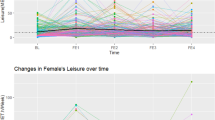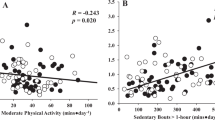Abstract
Evidence on long-term trends in physical activity is limited. We report that resting pulse rates – a proxy indicator of physical activity and fitness – increased among young adults attending Glasgow University between 1948 and 1968.
This is a preview of subscription content, access via your institution
Access options
Subscribe to this journal
Receive 12 print issues and online access
$259.00 per year
only $21.58 per issue
Buy this article
- Purchase on SpringerLink
- Instant access to full article PDF
Prices may be subject to local taxes which are calculated during checkout
Similar content being viewed by others
References
Wilkin T, Voss LD . Physical activity in young children. Lancet 2004; 363: 1162–1163.
Chasen-Taber S, Rimm EB, Stampfer MJ, Spiegelman D, Colditz GA, Giovannucci E et al. Reproducibility and validity of a self-administered physical activity questionnaire for male health professionals. Epidemiology 1996; 7: 81–86.
McCarron P, Davey Smith G, Okasha M, McEwen J . Life course exposure and later disease: a follow-up study based on medical examinations carried out in Glasgow University (1948–1968). Public Health 1999; 113: 265–271.
Chan CB, Ryan DAJ, Tudor-Locke C . Health benefits of a pedometer-based physical activity intervention in sedentary workers. Preventive Medicine 2004; 39: 1215–1222.
Kannel WB, Wilson P, Blair SN . Epidemiological assessment of the role of physical activity and fitness in development of cardiovascular disease. Am Heart J 1985; 109: 876–885.
Edholm OG . The Society's lecture: the changing pattern of human activity. Ergonomics 1970; 13: 625–644.
Talbot LA, Fleg JL, Metter EJ . Secular trends in leisure-time physical activity in men and women across four decades. Prev Med 2003; 37: 52–60.
Black A, Murray L, Cardwell C, Davey Smith G, McCarron P . Secular trends in heart rate in young adults, 1949–2004: analyses of cross-sectional studies. Heart 2005 [Epub ahead of print].
Helmchen LA . Can structural change explain the rise in obesity? A look at the past 100 years. Discussion Paper 2001-09 (http://www.src.uchicago.edu/prc/pdfs/helmch01.pdf) accessed 2/9/04.
Okasha M, McCarron P, Davey Smith G, Gunnell D . Trends in body mass index from 1948 to 1968: results from the Glasgow Alumni Cohort. International Journal of Obesity 2003; 27: 638–640.
Acknowledgements
Funding: Chest, Heart and Stroke, Scotland, Stroke Association, NHS Management Executive, Cardiovascular Disease and Stroke Research and Development Initiative. The authors would like to thank Alan Kerr, Christine Hamilton, and Heather Learmonth for entering the data. PMcC is supported by a Department of Health public health career scientist award.
Author information
Authors and Affiliations
Corresponding author
Rights and permissions
About this article
Cite this article
Smith, G., Galobardes, B., Jeffreys, M. et al. Trends in resting pulse rate among students attending Glasgow University between 1948 and 1968: analyses of cross sectional surveys. Int J Obes 30, 380–381 (2006). https://doi.org/10.1038/sj.ijo.0803139
Received:
Revised:
Accepted:
Published:
Issue Date:
DOI: https://doi.org/10.1038/sj.ijo.0803139



